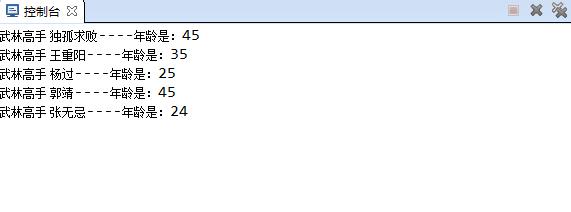1. Collection集合自定义对象并遍历案例(使用迭代器)
(1)首先定义一个Student.java,如下:
1 package com.himi.collectionIterator; 2 3 public class Student { 4 private String name; 5 private int age; 6 7 8 public Student(String name, int age) { 9 super(); 10 this.name = name; 11 this.age = age; 12 } 13 public String getName() { 14 return name; 15 } 16 public void setName(String name) { 17 this.name = name; 18 } 19 public int getAge() { 20 return age; 21 } 22 public void setAge(int age) { 23 this.age = age; 24 } 25 26 27 }
(2)CollectionIteratorDemo.java,如下:
1 package com.himi.collectionIterator; 2 3 import java.util.ArrayList; 4 import java.util.Collection; 5 import java.util.Iterator; 6 7 public class CollectionIteratorDemo { 8 9 public static void main(String[] args) { 10 //创建集合对象 11 Collection c = new ArrayList(); 12 13 //创建学生对象 14 Student s1 = new Student("独孤求败", 45); 15 Student s2 = new Student("王重阳", 35); 16 Student s3 = new Student("杨过",25); 17 Student s4 = new Student("郭靖", 45); 18 Student s5 = new Student("张无忌", 24); 19 20 //集合中添加元素(元素是对象) 21 c.add(s1); 22 c.add(s2); 23 c.add(s3); 24 c.add(s4); 25 c.add(s5); 26 27 //使用迭代器进行迭代 28 Iterator it = c.iterator(); 29 while(it.hasNext()) {//使用while循环进行迭代遍历 30 Student s= (Student)it.next(); 31 System.out.println("武林高手 "+s.getName()+"----"+"年龄是:"+s.getAge()); 32 } 33 34 } 35 36 }
运行效果如下:
